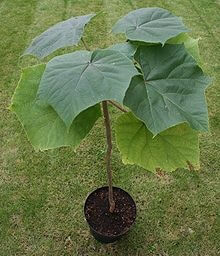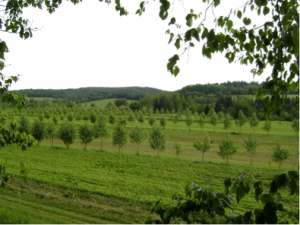Paulownia is a popular investment hardwood tree because of its high growth rate and the quality of the timber. Different variants can be grown for timber, ethanol or biomass. Paulownia elongata is one of the most popular variants as it is one of the fastest growing trees. Paulownias timber is high quality because it has one of the best strength ratios and it is used in planes, ships, musical instruments, surfboard and caravans. Because of these characteristics, it’s called the “Aluminium of the timbers”.
The tree originates from SE China, and there are several variations of it:
• P. FORTUNEI
• P. TAIWANIANA
• P. ELONGATA (The fastest growing variety of Paulownia)
• P. FARGESII
• P. AUSTRALIS
• P. TOMENTOSA
• P. KAWAKAMII
Each variant has its own characteristics and is adapted to different soils and climate. For the German environment, a special hybrid was developed in the laboratory, which combines fast growth and winter hardiness.

Paulownia can grow in many different soils, it prefers sandy and well-drained soils with a ph ranging between 5 to 8.9, on the other hand, it does not grow well in clay soils which have more than 25% clay. Young Paulownia will develop good root systems in soils with a depth of 1.5 to 2 meters; this stimulates faster growth.
Strengths
Fast growing trees, especially of the hardwood variety increase the yield from the land. The faster the timber grows to maturity the shorter are the cycles for timber production. This is why investors have been paying special attention to Paulownia elongata.
The Wood:
- The wood of this tree is in demand because it has one of the highest ratios of strength to weight, it is water-resistant and does is subject to limited warping and deformations.
- It is a sought after wood for home furniture because it is easily processed and is somewhat fire resistant as it burns at 400.
- The wood is also ideal for garden furniture and outdoor timber flooring as it is resistant to decay.
- Paulownia timber can be processed without a wood drying kiln. It can be air-dried in 30 days. Moisture retention is in the region of 10-12%.
- It is used in musical instrument production because of its resonance characteristics.
The tree:
- On average, on the 8th year Paulownia reaches 40cm of trunk diameter in the tropics, in the German climate growth is slower, but this creates a denser timber that in turn has a higher value.
- Paulownia Elongata can tolerate temperatures from between –28 and 40 Celcius.
- In the first years, In Germany, the growth is about 2 metres in height and 3 cm in diameter annually. In the tropics, it can achieve even faster growth rates.
- Paulownia weighs an average of 250kg/m3.
- For timber plantations, the recommended no of trees per hectare is around 400-700 per hectare, and for biomass plantations, the recommended no of trees per hectare varies between 4000 and 9000.

Paulownia Seedling
Weaknesses
- Severe winds can damage young Paulownia trees.
- Paulownia plantations are ideally irrigated as the young trees need around 1000mm of water per hectare per year, between the 1st and 2nd seasons it needs to be watered at least every seven days and between the 2nd and 4th season the tree needs to be watered 40 – 50 litres weekly?
- Branches which do not receive enough sunlight will die.
- Growth rates are increased if the plantation is ploughed as deep as 80cm when the seedlings are planted.
- Harvesting of Paulownia for Biomass is usually done after the third year and for timber after years 12 to 5, depending on the location. The trees need time to grow, and these growth rates are some of the fastest for any tree in the world, in fact, Paulownia is amongst the ten fastest growing tree species in the world.
Opportunities
- Paulownia Elongata enriches the soil with humus, making the soil richer in nutrients and active micro-organisms. This gives the soil the ability to retain water better.
- Intercropping between the trees is possible; this is an additional source of revenue. Intercropping is a system of planting the annual crops between the trees. The plants will build up the nitrogen content of the soils when their roots and discarded parts rot in the soil.

- One hectare can hold between 550 to 700 Paulownia elongata, fast growing trees.grows fast in temperature around 27°C.
- It grows fastest in temperatures of around 27°C.
- In the first year growth, it can reach a height of 2 to 4 meters, depending on location.
- After the 4th season, Paulownia roots reach a depth of 6 meters and it can extract enough water from the soil to sustain itself.
- The tree leaves can grow substantially with high nitrogen fertilisers. However, this will lead to higher losses of water evaporation from the larger leaves.
- In the case of damage, the tree can be cut to ground level, and it regenerates itself.
- A hectare of Paulownia can capture the carbon emissions from a family of four.
- Given the lightness and low moisture of the wood, the transport costs are cheaper than other woods.
- Paulownia weighs around 250 kg/m3.
- This tree increases the production of honey, as it’s flowers help the bees to make it.
- The pulp can be used for paper production.
Investment:
- The price of timber is loosely correlated with the stock market, this tree is an interesting vehicle for diversification.
- The price of timber is inflation proof.
- The land and the trees are a real asset, unlike a paper asset.
Threats
- Paulownia tolerates drought better than it does excess water or flooding. The fast growing trees tolerate drought to some extent, but growth will be significantly slower in this case.
- Herbivorous animals like young Paulownia seedlings, however, there are no known wood pests for Paulownia wood.
- Weeds can hinder the growth of Paulownia in the first years of growth, as they compete for both nutrients and light.
- It is common that weed killers such as round up are used on Paulownia plantations. Some organisations have linked round-up has been linked to the death of bee populations.
- Like any seedling, young Paulownia can be burnt if fertiliser is applied too close.
- Wind speeds of 30km can damage young Paulownia trees.
- Paulownia Tomentosa has been classified as invasive species in some US states.
- Paulownia elongata risk assessment by the Hawaiian Ecosystems at Risk project.
- Land taxes.
Conclusion:
This tree and its hybrid versions provide an interesting investment for both farmers and investors. Farmers can use this tree to use their marginal farmland while investors can invest a whole plantation of this fast-growing tree.







